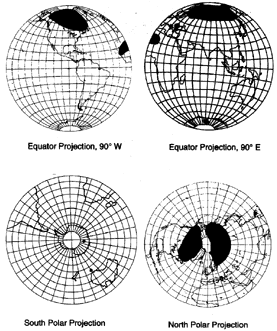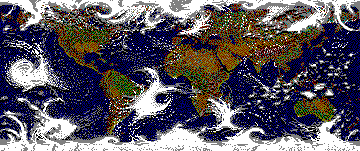 It
Is Hot
It
Is Hot
It Is Cold
It Is Climate
Chad Muszynski and
Kia Berry
 It
Is Hot
It
Is Hot
It Is Cold
It Is Climate
Chad Muszynski and
Kia Berry
Climate remains an important aspect in the lives of every living thing. This chapter will take a more indepth look into the climate as it relates to different issues. We will begin by taking on the difficult challenge of defining climate and exploring briefly why it is important.
After scratching the surface we will go more indepth with five topics. These topics include: Coping with Climatic Change, Climate and Living Things, Climate and Development, and Weather conditions (to be found on the web site only). These topics will take you on a journey through a topic that affects your life every day.
What is Climate and Why is it Important:
Climate is the average condition of the weather over several decades, as exemplified by such characteristics as temperature, wind velocity, and precipitation. Climate is not merely the average weather events but rather the sequence of weather events compose the climate. Climate is important for several reasons. First, the climate affects the day to day activities of every living thing. Most importantly the climate can make a significant impact of the health of living things, especially humans. Along with health, the nutrition of many living things can be affected by the climate. Finally, climate conditions are important because itaffects societies development and the ways in which the earth changes over several decades.
Climate and Living Things:
The climate has a major effect upon the people living within it. For example a hot wet climate can make people feel lazy while a cool climate may make those same individuals energetic. Some climate in the world are so cold that individuals are forced to dress warmly all the time. Other climate require only light clothing the entire year.
The climate affects other living things besides humans also. In particular, plants are clues to the climate of an area. Only low-growing hardy plants manage to survive in the world's coolest places. Large full evergreens on the other hand grow where summers are warm or cool, and winters are long and cold. Grass covers most of the drier land in warm and cold climates while only drought-defying plants, such as cacti, survive in the driest climates. Following are a few different climates and the ways in which they affect living things.
Tropical Rainy Climates
In most countries there is a noticeable difference in seasons. Close to the equator, however, there are no seasons. Here people have much of the same kind of weather day after day throughout the entire year.
Plants and creatures that need a warm moist climate thrive close to the equator. Here, plants grow faster and closer together. One scientist worked out that there must be 64 million plants in each square mile in the forests of southern Malaya. In Indonesia more than 30,000 species of flowering plants are identified and this is 15 times as many kinds as in the British Isles.
The Great Grassland
The great grasslands can be categorized by either the tropical grasslands or the temperate grasslands. Tropical grasslands, or savannas, cover much of Africa and parts of South America, and India. This area tends to have dry, warm winters and wet, warm summers. The dryness comes from the mass of warm, dry air that lies above some continents.
The main savanna plants are tall grasses. African elephant grass grows much higher than a man. In winter, grass blades turn brown and die but when the rain begins the grass begins to take their place again. Many savannas simply look like open parks with scattered trees.
The largest temperate grasslands are the prairies in the heart of North America and the steppes which stretch from eastern Europe into Central Asia. Other temperate grasslands cover parts of south-east South America, Central Asia, southern Africa, south-east Australia and south-east New Zealand.
Temperate Climates
Between the sub-tropical deserts and the cold polar regions lie lands with temperate climates. Here the weather is neither always hot nor always cold. This description fits much of North America and Europe, and parts of southern South America, southern Africa, southern Australia, and New Zealand.
Cold temperate climates suit plants such as the oak tree which shed their leaves in winter. On the other hand the warm temperate climate is suitable for the tough-leaved shrubs and trees like the olive and the carob.
Along with different plants so do different animals live in these climate regions. The cold temperate climate sees skunks, squirrels, and hedgehogs that hibernate. While the warm temperate climate sees the lizard and tortoises because they can survive the summer droughts easily.
Although these are not all the climate regions in the world this gives you a sample of the ways in which living things must adapt to the climate that they dwell in. Without that adaptation living things would not be able to survive because of the many different climate regions.
Climate and Development
Climate has a dramatic affect on our daily lives. A number of studies have been conducted as to how climate has influenced the development of various societies and how changing future climates may affect our own society.
The primary reason to focus on climate as a factor in the development of any nation or society rests with the fact that agriculture dominates the economies of most developing countries. In low income countries nearly 70 percent of the population is directly dependent on agriculture for its livelihood. This, coupled with the fact that is nearly impossible for a country to develop, industrially or otherwise, without at least some basic agricultural level of self-sufficiency suggests the importance of agriculture to national growth and development. It is also painfully obvious that a region's climate plays a key role in the success of agriculture. Does this mean that certain regions of the Earth are destined to failure and are beyond hope? Twenty years ago the answer may have been yes, however today there is an increasing body of study into making farming successful around the world.
Initially, world leaders hoped to incorporate farming technologies from the more temperate regions of the world. These attempts, in many cases, failed for a variety of reasons. First, many countries did not give a high priority to developing the agricultural sector and chose instead to focus on industrial development. These futile attempts appear to be changing as leaders realize the importance of a strong farming base. A second reason for the failure to meet the expectations of the new technologies lies in the naiveté of those incorporating them. Frequently, plans to bring Western farming practices to the Third World failed to take into account varying soil types and climatic conditions.
Clearly different climatic conditions require different strategies for success. Strategies are currently being developed and implemented in those tropical areas which offer the most hope for future development. Some may be successful, most will fail. The real problems facing those working to improve strategies for coping with climate are similar to those that the currently successful temperate regions have faced in the past. There is still limited knowledge about tropical plants, many of which may be exploited as sources of food, fiber, and fuel. We need more information about tropical soils and how to reap sustainable yields from them. Also, tropical diseases that attack both plant and animal targets must be controlled. All of these problems can be solved given time. However, time is the enemy as populations continue to grow.
Coping with Climatic Change
There are a number of theories behind why climate changes over time. Among them are variations in the Earth's orbit, volcanic eruptions, changes in solar output, and increases in a number of "greenhouse" gases.
The Milankovitch theory was first proposed by the Yugoslavian astronomer in the 1930s. This theory suggests that three separate cyclical movements in the Earth's orbit combine to induce climatic changes. The first cycle deals with changes in the eccentricity, or shape of the earth's orbit around the sun. Over the course of a 100,000 year cycle the earth's orbit changes from elliptical to nearly circular and back to elliptical. This variation brings the earth closer to the sun as it becomes more circular. With the earth closer to the sun, more energy is received and the planet warms. Figure 1 illustrates this change.
The second cycle concerns the precession of the earth on its axis. This "wobble" effect acts much like a spinning top swinging back and forth as it rotates in order to maintain equilibrium. This cycle of precession occurs in a 23,000 year cycle. Currently the northern hemisphere is closer to the sun during January. In about 11,000 years the opposite will be true as the southern hemisphere moves closer and the earth's tilt is reversed. This precession cycle may have a strong influence on how severe seasonal changes are, particularly at the mid to high latitudes.
The third cycle deals with changes in tilt, or obliquity of the earth. Presently the earth's tilt on its axis is about 23.5 degrees. Over the course of this 41,000 year cycle the tilt can vary from 22-24.5 degrees. The smaller the angle, the less seasonal variation experienced on earth.
The following figures gives a graphic illustration of these cyclical effects known collectively as the Milankovitch theory.
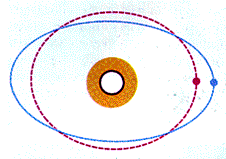
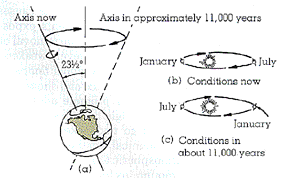
The Eccentricity Effect and the Precession and Obliquity Effects
Together these Milankovitch cycles were thought to be the driving force behind long term ice ages and global warming patterns. Today, with improved mathematical modeling of global climates, it appears that these changes are not enough to trigger a major glaciation or ice cap melt. However, these cycles combined with differences in albedo, sea surface temperature, and other secondary factors could lead to significant changes in global climate.
Climatic changes can also arise due to volcanic eruptions. A major volcanic eruption might lower the global temperature .2 degrees C. While this may not sound like much, on a global scale this can have strong effects. The reason for this cooling lies in the fine particles of ash and dust that are released into the air. These particles tend to reflect more solar radiation away from the earth, much the same way clouds keep you cooler in the summer. These particles also combine with water vapor to produce a haze of sulfuric acid particles that can have climatic influences for several years before dissipating.
A third cause of climatic variation results from changes in solar output. Sunspots, cooler regions on the sun's surface, occur in 11 year cycles. As the number of sunspots increases, the total radiation output of the sun increases due to large radiational increases surrounding the sunspots. This increase in solar radiation can cause the earth to warm. Likewise, periods of low sunspot activity, may lead to lower radiation outputs and lower surface temperatures on earth. The next period of low activity is due in 1997.
Perhaps the greatest challenge facing humankind in the coming years will be finding ways to cope with the greenhouse effect. This effect is a concern to many as the release of carbon dioxide and other greenhouse gases into the atmosphere will cause global temperatures to rise and could lead to dramatic shifts in local climates. Others suggest that the greenhouse effect is not a problem because counteracting factors will work to negate most if not all of the global warming predicted.
First of all, what is the greenhouse effect? Without getting too involved, as this topic will most likely be touched on in greater detail in a later chapter, the greenhouse effect involves the retention of solar energy by the Earth's atmosphere. We already live with this effect every day as the earth's atmosphere keeps the average global temperature about 33 degrees C (59 degrees F) warmer than it would be in the absence of an atmosphere. The problem lies in the fact that the earth is gradually warming by retaining more heat than it reflects back into space. Due to a build up in such gases as CO2, CH4, CFCs and others (see below), our planet's atmosphere reflects more energy back to the surface. Perhaps the greatest problem resulting from this buildup stems from the positive feedback effects that will result, most notably an increase in atmospheric water vapor, the most potent greenhouse gas, due to oceanic evaporation.
The following two charts show CO2 variations found in ice core in the Antarctic. Clearly there has been an upward trend since the beginning of the Industrial Revolution. The most recent trends (left diagram) show that the increase in CO2 appears to be accelerating over time.
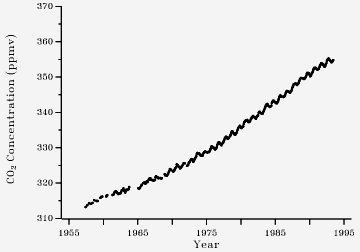
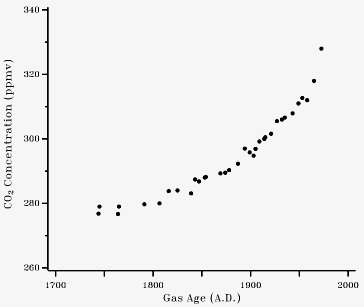
Past 40 Years and past 300 Years
Working to counteract this warming effect are the oceans themselves. They act as huge storehouses for CO2 thanks to phytoplankton and other microscopic plants. An increase in global temperature could trigger increased growth of these organisms. The ocean waters also have a huge capacity to store heat energy. However, a warmer ocean actually holds less CO2 than a colder one. Because of the numerous counteracting effects that are possible, scientists have been unable to reach a consensus as to the consequences of the greenhouse effect.
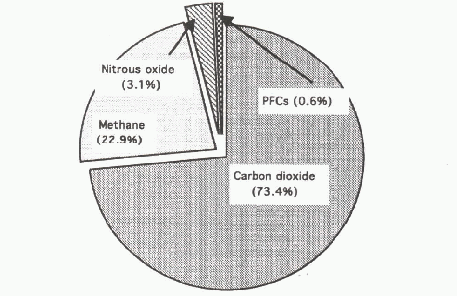
The chart illustrates the breakdown of significant greenhouse gases
in our current atmoshere.
For now, let's assume that the earth is warming and will continue to grow warmer. What shifts in climatic patterns can we expect? To begin with, some models predict that an increase of 3-4 degrees C would cause the jet stream to weaken and global winds to alter their "normal" pattern. This would result in changes in precipitation patterns and amounts over much of the world. These new patterns could have adverse effects on agriculture and plant life. Additionally, such warming would cause portions of the polar ice caps to melt, raising sea levels as much as a half meter world-wide. The higher water levels could damage some shorelines and might contaminate coastal groundwater supplies. These warming trends are shown here.
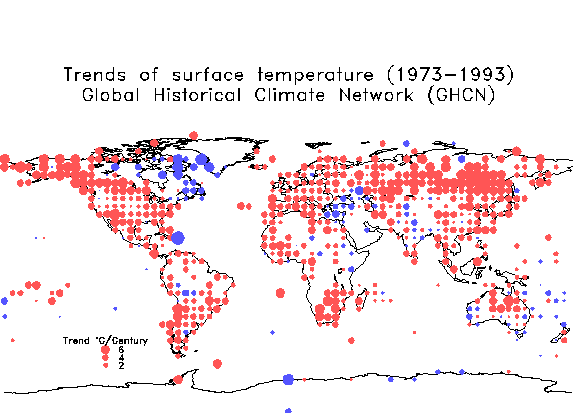
Scientists disagree on how global warming would influence plant growth across the Earth. Some predict that higher CO2 levels would induce plant growth and lead to increased vegetation. Others predict that insects might actually eat more as a result of the new plant growth and that net vegetation would decrease as a result.
Global climate models have been introduced to improve our understanding of the consequences of these effects. Scientist have developed huge computer programs utilizing hundreds of mathematical variables to try to predict future climatic changes. Atmospheric, oceanic, land and vegetation, and astronomic variables all come into play in these models. Unfortunately, even the best of these models have their limitations. For example, the best GCM (Global Climatic Model) in the US must assume reduced levels of solar heating than we actually receive in order to emulate current conditions. In fact every major model presented in the past twenty years has had to make false assumptions in order to get the present right. With so many difficulties in modeling the present one can imagine how difficult it is to model the future. Additionally many models utilize complex atmospheric analysis alongside simple oceanic variables. With our current limited understanding of how each variable influences every other variable, it is very difficult if not impossible to know exactly how serious our situation will be in the future.
This chart shows the difficulty scientists have had in trying to predict global warming trends utilizing today's climatic models.
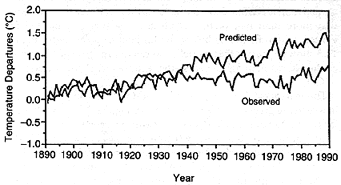
Regardless of the problems with our current GCMs, they all reach similar conclusions. The Earth is warming and can be expected to continue to do so into the immediate future. Steps must be taken now to reduce emissions of CO2 and other greenhouse gases before a runaway greenhouse effect results.
A Few Final Words...
Climate plays an important role in how we live. Climatic differences can influence a society's development, the growth and health of living things, and how we go about our daily lives. It is important not only to understand today's climate, but also to try to predict future climatic changes. Only by doing so can we preserve the quality of life we have today, and adapt to create a better world tomorrow.
In order to predict these changes and cope with them, we need to first work to determine the exact results of increased greenhouse gases, deforestation and other factors at work in this process. Meteorologists are working towards better models to predict these changes. Additionally, we need to alter our behaviors to bring these agents of climatic change under control. International treaties to ban the use of CFCs in propellants and attempts to curb the deforestation of the Amazon are a step in the right direction, but there is still work to be done. We may never be able to control the climate of any region, but we can certainly take steps to prevent future consequences of unknown proportions.
Additional Sources of Info
From the Source(s)
Ahrens, C. Donald. Meteorology Today. New York: West Publishing, 1991.
Biswas, Asit K. Climate and Development. Dublin: Tycooly International, 1984.
Graedel, Thomas E. and Paul J. Crutzen. Atmosphere, Climate, and Change.Scientific American Library, 1995
Gribbin, John. What's Wrong with Our Weather? The Climatic Threat of the 21st Century." Charles Scribner's Sons, 1979.
Kellogg, William W. and Robert Schware. Climate Change and Society. Boulder: Westview, 1981.
Lambert, David and Ralph Hardy. Weather and Its Work. Facts on File Publications, 1984.
Rajamanickam, Dr. G. Victor. Sea Level Variation and its Impact on Coastal Environment. Thanjavur: Tamil University Press, 1990.
